Jon Anderson’s solo debut, Olias Of Sunhillow, is reissued this week in a double-disc set comprising a remastered CD plus an audio DVD. I’d been hoping for some time that this album might be given a proper reissue, it’s one I like a great deal but my old CD has never sounded as good as it ought to. The album may command cult status round here but you don’t see it mentioned anywhere outside Yes forums or partisan enclaves like the Prog Archives. This post may be taken as a small corrective to the neglect.
Olias Of Sunhillow was released in 1976, and was the most unusual of all the solo albums recorded by the individual members of Yes in the mid-70s, being a spin-off from some of the group’s early albums, or at least their cover art. Roger Dean’s first cover work for the group was on Fragile in 1971, for which he painted a miniature world rather like one of MC Escher’s planetoids. This was Dean’s idea, the band had suggested a broken piece of porcelain as the cover image. The back cover of the album showed the same planet in a state of fragmentation with a fish-like spaceship floating above it (see below). Another drawing of the fish-ship was added to the front cover before the album’s release, and it’s this ship, and the narrative it suggests, that leads eventually to Anderson’s solo album. Two years after Fragile, the planetary disintegration had turned into an exodus on the group’s triple-live album, Yessongs, the back cover of which shows pieces of planet being towed through space by a similar fish-ship. The other panels of the cover depict the arrival of these fragments on a newer, larger world. Anderson’s album takes this sequence of events then filters them through Vera Stanley Alder’s mysticism to craft a musical odyssey which Discogs describes as:
…the story of an alien race and their journey to a new world due to catastrophe. Olias, the title character, is the chosen architect of the glider Moorglade, which will be used to fly his people to their new home. Ranyart is the navigator for the glider, and Qoquaq is the leader who unites the four tribes of Sunhillow to partake in the exodus.
For many years in British music circles it would have been a grave error to even acknowledge this album’s existence, never mind admit to actually liking it. This was partly the old animus against progressive rock, an unexamined prejudice that lasted well into the 1990s, but Anderson’s album had so many strikes against it that it might have stood as the winner of a disapproval lottery for the more ideologically rigid writers and readers of the NME. It’s Jon Anderson (strike 1), the lead singer of progressive rock (2) group Yes (3), whose album is a science fiction (4)/ fantasy (5) concept (6), littered with Tolkien-like invented names and words (7), and with a multi-page sleeve embellished with detailed fantasy illustrations (8) by David Fairbrother-Roe. The design was art directed by Hipgnosis, who subsequently designed the next two Yes albums. Anderson originally wanted Roger Dean to create the packaging, which would have provided a further strike of disapproval against the album, but Dean’s career had gone into overdrive following the publication of Views so he either didn’t have the time or didn’t want to be involved. In Views Dean mentions “another project” based on the fish-ship’s journey which may be a reference to Anderson’s forthcoming album, the credits of which thank Dean for “planting the seed”.
Roger Dean’s original artwork for Fragile (1971). Another fish-ship was added to the final cover art.
Concept albums were a perennially popular thing in the 1970s, with many of the concepts involving cosmic or science fiction themes. From 1970 to 1979 you could concept-out with Blows Against The Empire (1970) by Jefferson Starship, Space Ritual (1973) by Hawkwind, Mekanïk Destruktïw Kommandöh (1973) by Magma, Diamond Dogs (1974) by David Bowie, Rick Wakeman’s Journey To The Centre Of The Earth (1974) and No Earthly Connection (1976), 2112 (1976) by Rush, In Search Of Ancient Gods (1976) by Absolute Elsewhere, Hope (1977) by Klaatu, I Robot (1977) by The Alan Parsons Project, multiple albums by Parliament during their Mothership phase, Jeff Wayne’s The War Of The Worlds (1978), The Pentateuch Of The Cosmogony (1979) by Patrick Woodroffe & Dave Greenslade, and Replicas (1979) by Tubeway Army. Parliament aside, almost everything above is a rock album of some sort. Anderson’s album was unusual for the way it ignored familiar rock structures in favour of long instrumental passages, polyphonic chants, and songs created by layering voices, synthesizers, harp and percussion. Listening to a friend’s copy soon after its release I found the whole thing to be very strange, although this was mostly due to lack of context when I’d not heard much genuinely strange music at all. The wizards-in-space storyline didn’t really interest me; it’s there inside the cover if you require it, and may be read with a magnifying glass on the pages of the new digipak. But I did like the music, especially the compositions that sound as though the more evocative moments of Tales From Topographic Oceans have been extended to create a series of folk songs for an alien civilisation. In other hands this might not work at all but Anderson’s experience as a song-writer sustained him in a manner which completely eluded Rick Wakeman on No Earthly Connection, another collection of cosmic songs released a couple of months before Olias Of Sunhillow, and one I find to be unlistenably bad. (I tried again for the purposes of this post.)
Yessongs—Escape by Roger Dean.
Compared to Wakeman, Anderson in the mid-70s would have been regarded as an accomplished singer but an amateur musician, even though he regularly played harp and acoustic guitar on stage with Yes. He acknowledges his inexperience in the reissue notes while also describing his determination to make a true solo album, one on which he played everything himself, assisted by a single recording engineer, Mike Dunn. There’s nothing amateurish about the end results, even though Anderson had to teach himself to play keyboards before going into the studio. The album is book-ended by songs that sound like Yes out-takes but between these are a series of musical suites that are unlike Yes or anything else from 1976. The first half of the album details the creation of the exodus ship and the gathering of its passengers and crew, ending with the departure from the planet. The second half is the journey through the cosmos (Solid Space), the overcoming of spiritual obstacles (Moon Ra) and the arrival at a new world. Anderson condenses his storyline into lyrics that are often as elusive as those he wrote for Yes, thereby avoiding the narrative elaboration that spoils many concept albums. It’s tempting to wonder how Roger Dean might have illustrated this story. Dean put spacecraft onto the Yes album covers but beyond occasional allusions such as Starship Trooper on The Yes Album, “cosmic” in the world of Yes usually refers more to metaphysics than astrophysics. Anderson’s album is a curious blend of the two, closer to science fantasy than Dean’s realist approach to futuristic hardware and architecture. The title Solid Space always makes me think of the old idea that the interstellar regions were permeated by a physical “ether”, while the song itself sounds closer to a genuine space hymn than those recorded by Ramases on his Space Hymns album a few years before.
Yessongs—Arrival by Roger Dean.
Anderson’s song cycle reaches a peak in the second half with a long suite in three parts: Moon Ra (a nod to Sun Ra?) is an evolving chant, all layered percussion, synthesizer and vocal utterances (including grunts and growls) that must have pushed the limits of 24-track recording. This builds to a tremendous wave-like crescendo that leads to the second part, Chords, which in turn diminishes into Song Of Search, a synthesizer coda very reminiscent of the symphonic keyboard compositions of Anderson’s friend and frequent collaborator, Vangelis. Anderson’s use of synthesizers is close enough to the Vangelis sound to have generated a persistent rumour that the Greek maestro secretly helped with the recording. The reissue notes dismiss this story as they also dismiss a further rumour that Vangelis had been accused by RCA of moonlighting on another label. The really surprising thing about the recurrent Vangelis-like quality of Anderson’s album is that it sounds in places like recordings Vangelis made after its release, the China album in particular. The similarities are no doubt coincidental, and possibly a result of heavy use by both parties of the pentatonic scale, but Anderson’s combination of Mini-Moog melodies with bells and chimes creates an unmistakably Vangelis-like flavour. Anderson had sung the rather insipid So Long Ago, So Clear on Vangelis’s Heaven And Hell album in 1975, and in the Olias reissue notes he credits Vangelis with urging him to greater spontaneity in his singing. But Vangelis was always more than a mere keyboard player. By the mid-70s his compositions incorporated a wide variety of percussion and stringed instruments which I’m sure must have made an impression on Anderson after so many years of working in bands. Here was a musician doing everything himself. (Well…almost. Vangelis can’t sing.)
Yessongs—Awakening by Roger Dean.
Influence aside, the success of Anderson’s arrangements is apparent when comparing them to those of Dave Greenslade on The Pentateuch Of The Cosmogony, an album that may have taken Olias Of Sunhillow as its model. Where Anderson’s album is packaged to look like an ancient volume, Pentateuch was an actual hardback book, published by Roger Dean’s Paper Tiger imprint, with two vinyl discs inside. Woodroffe’s storyline is a similar tale of planetary destruction and interstellar exodus, albeit presented in much more detail. Anderson invented a few names for his story but Woodroffe has an elaborate symbolic language to accompany his mythology and his beautifully detailed paintings. I like the art for this album, which subdues the tweeness prevalent in much of Woodroffe’s other work, but the music is often thin and undeveloped in comparison to Anderson’s, and it outstays its welcome over four sides. Greenslade is from the same Prog-Liberace school of classical pastiche as Rick Wakeman, so we’re given a series of baroque synth tunes with detours into rock instrumentals, together with lukewarm attempts at funk or disco that lack the muscularity of the futuristic dance grooves being produced by Cerrone, Patrick Cowley and others.
Yessongs—Pathways by Roger Dean.
What I like about Olias Of Sunhillow today is that it sounds like the kind of album that Anderson might have made with Vangelis after Heaven And Hell. The pair continued to collaborate well into the 1980s, and even provided Donna Summer with a hit single when she covered State Of Independence, but their songs avoided the far-out lyrics and mystical tendencies of Yes. Anderson’s subsequent solo albums have been a lot more earthbound although he has teased a sequel to the story of Olias. I think I’d prefer his debut to be left as it is: a surprising and remarkable solo album whose unique qualities are partly a result of overcoming limitations with ingenuity and careful composition. Anything new would undoubtedly be more accomplished and much more predictable.
Previously on { feuilleton }
• Science Fiction Monthly
• Roger Dean postage stamps
• Roger Dean book covers
• Roger Dean: artist and designer

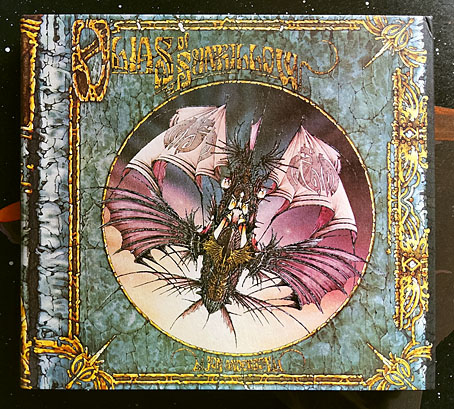
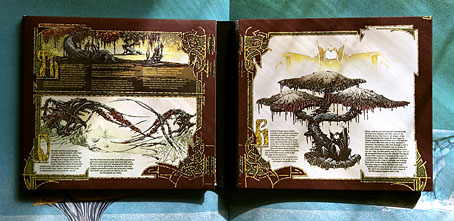

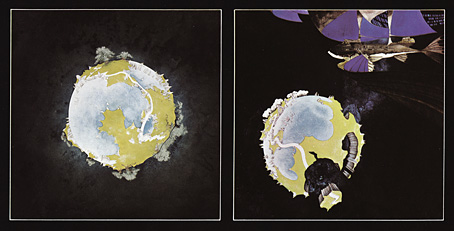
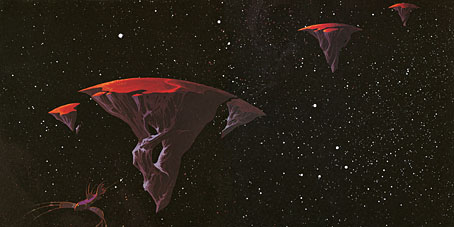
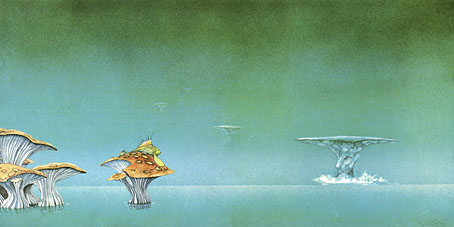
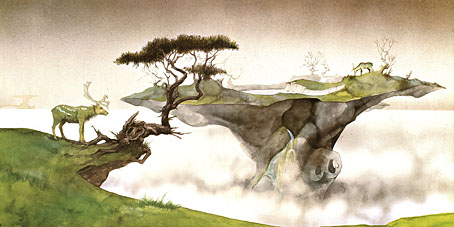
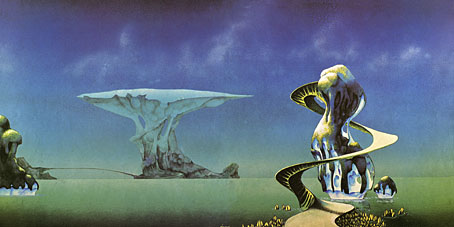
Thank you for this. I wasn’t aware of the rerelease, and it’s welcome. On streaming services, the album has the wrong track order (fairly easy to fix with a playlist, but still).
A spiritual successor (musically, that is) to Olias that I can recommend is Johannes Luley’s Tales from Sheepfather’s Grove. It doesn’t rip off Anderson, but buildds its own world, and I find it sadly overlooked.
We had our own Music Police over here in the states of course. I was a kid and thankfully naive enough to be unaware that I was supposed to throw out my YES albums because I loved Horses and Marquee Moon.
Anderson has no reason to lie but maybe Vangelis at least provided some advice about programing the synths?
John: Thanks for the recommendation. I’m happy for Anderson’s album to be a unique artefact but sometimes you also wish there was more that sounded like this.
Stephen: There were a lot of people like this but their tastes were never reflected in the more doctrinaire quarters of the music press. The attitude used to annoy me but it never stopped me liking what I did. “Guilty pleasures” be damned. Oddly enough, I always think of the track Marquee Moon as being progressive rock in new wave clothes: 10 minutes long, and half of it taken up with a guitar solo.
Yes had been using synthesizers since 1971 when they famously sacked Tony Kaye as keyboard player because he wanted nothing to do with the Mini-Moog. I’ve messed around with analogue synths since the late 1970s (a friend was a session musician), and they’re easy to operate, especially the smaller ones where all the wiring is internal. So prior to Olias, Anderson had four years on the road and in the studio with Rick Wakeman and Patrick Moraz’s gear to hand. If there’s a Vangelis influence I’d say it’s more a case of him (consciously or not) shaping the sounds into Vangelis-like timbres.
This was played on the radio at release in 76 and I bought it as soon as it hit the stores. A masterwork. I confess to agreeing with your ascertain that a sequel would never live up to this (but I hope I’m wrong). Your work is also in a universe all its own. Thank you for your thoughts
Thank you for this well written observation of one of my all time favorite releases. I have read for years & years that Jon wants to do a follow up to this masterwork. For me the only way to approach this would be for Anderson to play all the instruments again. Real playing of real instruments: no samples or drum machines, no sequencers or digital sounding replications of playing techniques.
The “ancient/future” vibe of the original album is a perfect balance between organic instruments and analogue synths.
Excellent review!
Quibbles:
I don’t think Anderson played harp with Yes before the band’s 1976 ‘solo albums’ tour, which started a month or so before Olias was released. Anderson’s segment for most of that tour was a short, beautiful instrumental fantasia for harp and synthesizer that sounds like it could have been an Olias outtake. On bootlegs it’s sometimes named ‘Sunhillow’.
As for later Olias-like music …. ‘Far Away In Baagad’ from ‘Short Stories’ (1980), Anderson’s first full length collaboration with Vangelis, has Olias-like fantasy lyrics set against a roiling backdrop of synth and percussion.